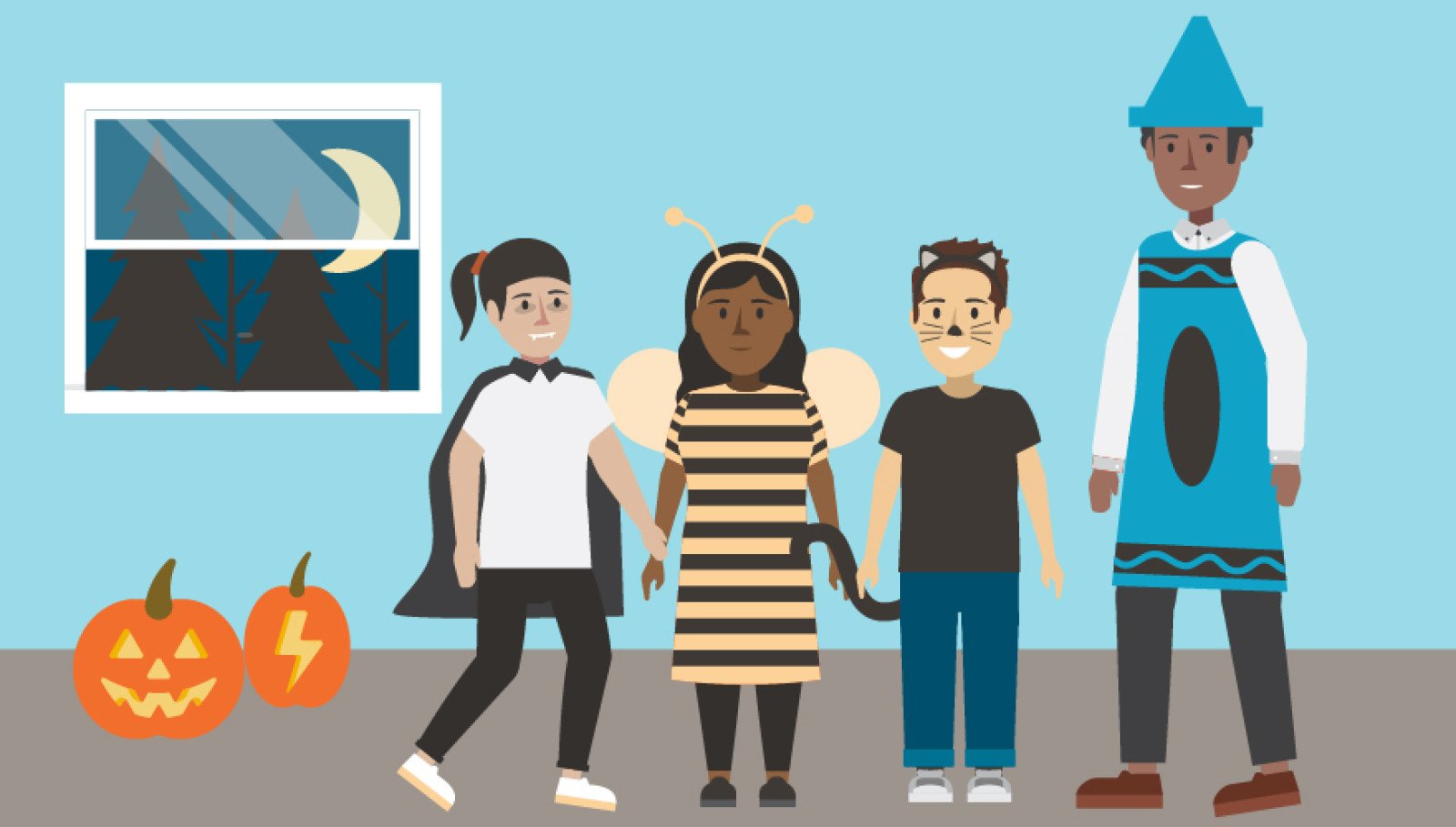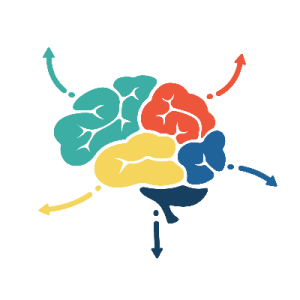Halloween tips and tricks or treats
A Halloween Mad Lib activity for the whole class.

Overview
Using Mad Libs students will learn about different energy-efficient tips through story. Students will think and practice learning words in creative ways. This activity is designed to help students use language to identify, create, and share ideas with others.
Instructions
What you'll need
- "Halloween tips and tricks Mad Lib" worksheet, 1 per student or 1 per pair
- K - 3 worksheet
- Grade 4 -7 worksheet
- Pencils, 1 per student or per pair
- Start by asking students: “How do they light up their jack-o-lanterns at home?” Possible answers may include candles, LED light, flashlight, or left unlit.
- Alternatively, if jack-o-lanterns are carved in the classroom, ask students what they would suggest using to light jack-o-lanterns?
- Explain to students that they will participate in the Mad Lib activity. Depending on the reading and comprehension level of your class, explain different types of words used in the activity.
- You can choose to pair students to fill in the blanks or this can be done by a teacher-led activity.
For teacher-led activity, tell students they'll participate in a “Mad Lib” word game. Here are the rules:
a. Print one "Halloween tips and tricks Mad Lib" worksheet and ask the class for types of words to fill in the blanks. For example, a colour, a name, a type of food, etc. Assist students by providing examples:
Name of a person: Alex
Kind of animal: racoon
Funny sound: squish
Colour: bright green
b. Once all the words are written down into the Mad Lib story, read the story out loud to the class.
c. Alternatively, you can repeat the activity using different words learned in the classroom. This is an opportunity for students to learn about different grammatical terms like nouns, adjectives, verbs, pronouns, prepositions, etc.
d. You can also ask students to raise their hands to volunteer their word suggestions.
For student-led activity, create groups of 2-3 students.
a. Give one "Halloween tips and tricks Mad Lib" worksheet per group.
b. Ask students to work in their groups to choose one word for each blank. Depending on the reading and comprehension level of the class, students may need help with some words.
Table 1: Example of word fill-ins for the Mad Lib
Describing word (adjective) | smelly, pretty, friendly, helpful, noisy |
Thing (noun) | shoe, teacup, watermelon, car, notebook |
Colour | pink, green, silver, white, orange |
Job/Profession | teacher, doctor, scientist, artist, singer, lawyer |
Action word (verb) | run, jump, talk, sing, eat, skip |
Food | pizza, noodles, curry, spaghetti, fish |
Type of sound/noise | laugh, squish, poof, boing, bang, ring, zing, zap |
Type of liquid | juice, water, swamp water, soup, slime, oil |
Word ending in “ing” (past participle) | jumping, running, swimming, drawing |
Word ending in “ly” (adverb) | gladly, happily, loudly, greatly, lovely |
5. After reading the story, ask the class comprehension questions about the elements of the story:
- Where does the story take place?
- Who are the main characters in the story?
- What elements in the story teach us about energy conservation?
- What's the conflict (problem) in the story?
Modify or extend this activity
Learn more about energy-saving tips with everyday home appliances and electronics
- Students may be most interested in the section about how to use laptops and tablets “smarter”
- Game consoles
- Energy saving tips
Kindergarten - Grade 3
Creative Writing
- Ask students to write their own story with their own characters. Ask students to think about using different grammatical terms to add details to their story.
- Ask students to write their own ending to the story. Optional: ask students to share their stories in small groups or in front of the class.
Home Challenge
- Make extra copies of the activity sheet and give students the option of taking it home and asking friends, or people they live with, to fill in their own words into the story. Ask students to read their stories out loud or in front of the class if they wish.
Grammar Challenge
- Depending on the reading and comprehension level in the class, challenge the class to a week-long Grammar word game. For each category in Table 1 (e.g. noun, verb, adverb, colour, name), create a separate envelope.
- Label each envelope with categories from Table 1, and tape these envelopes in a place where students can access them.
- Throughout the week, during your English Language Arts session, ask students to write words that match the categories in the Table.
- Students would write their words on recycled pieces of paper, and then drop them into the correct envelopes.
- At the end of the week, the teacher or student would select a word from each envelope that corresponds to each blank in the Mad Lib activity sheet.
- Then read the story out loud to the class.
Grade 4 - 7
Mad Libs Theater
- Turn completed Mad Libs stories into short skits or performances. This encourages students to think about the narrative and how it can be acted out.
- Emphasize the importance of storytelling and acting in this activity.
- Briefly review the components of a narrative, including characters, setting, plot, and dialogue. Ensure that students understand how these elements contribute to a story.
- Instruct students to adapt their Mad Libs stories into scripts. They should identify the characters and assign roles to classmates if the skit is presented to the class.
- If available, allow students to prepare simple props and costumes to enhance their performances.
- After each performance, facilitate a discussion about what worked well and what could be improved. Encourage constructive criticism.
Historical or Scientific Mad Libs
- Use Mad Libs to create educational content related to history or science. For example, fill in the blanks in a Mad Libs story about a historical event or a scientific concept.
- Select a historical event or scientific concept that students will focus on during the lesson. Allow students to select a topic or the teacher can choose topics and students are asked to pick a topic out of a bowl. Randomly selecting topics creates an opportunity for diverse perspectives and ideas because students will have the opportunity to explore topics that they wouldn’t usually select for themselves.
- Discuss the selected historical event or scientific concept, providing essential background information. Ensure students have a basic understanding.
Research-based Mad Libs
- Use Mad Libs to reinforce research skills. Students can create stories related to a specific research topic, adding terms they've learned in class.
- Provide a list of research-related terms and their meanings. Ensure that students understand terms such as "hypothesis," "data," "experiment," and "conclusion."
- Have students choose a specific research topic. It could be a scientific experiment, historical event, or a famous discovery.
- Instruct students to integrate the research-related terms into the Mad Libs template. For example, they might replace nouns, verbs, or adjectives with these terms.
- Encourage students to think creatively and construct a story that makes sense with the integrated terms. They should ensure that the research terms fit cohesively into the narrative.
Curriculum Fit
Kindergarten - Grade 3
Learning objectives
- Students learn about hidden energy consumption in their home.
- Students learn about the impacts of their actions on the environment through energy use and conservation.
- Students learn about how their actions can affect the environment and how changing their actions can lead to change.
Curriculum fit
English language arts
Core competencies
Communication and thinking
Big ideas
- Stories and other texts help us learn about ourselves and our families.
- Everyone has a unique story to share.
- Language and story can be a source of creativity and joy.
Curricular competencies
Comprehend and connect (reading, listening, viewing)
- Use developmentally appropriate reading, listening, and viewing strategies to make meaning.
- Engage actively as listeners, viewers, and readers, as appropriate, to develop understanding of self, identity, and community.
- Recognize the structure of story.
Create and communicate (writing, speaking, representing)
- Exchange ideas and perspectives to build shared understanding.
- Use language to identify, create, and share ideas, feelings, opinions, and preferences.
Grade 4 - 7
Curriculum fit
English language arts
Big Ideas
- Language and text can be a source of creativity and joy.
- Using language in creative and playful ways helps us understand how language works.
- Developing our understanding of how language works allows us to use it purposefully.
Curricular Competencies
Comprehend and connect
- Recognize how literary elements, techniques, and devices enhance meaning in texts.
- Use a variety of comprehension strategies before, during, and after reading, listening, or viewing to deepen understanding of text.
- Explaining how literary devices contribute to meaning (e.g., sound devices, figurative language)
- Think critically, creatively, and reflectively to explore ideas within, between, and beyond texts.
Create and communicate
- Use language in creative and playful ways to develop style.
- Taking risks in trying out new word choices and formats; playing with words, structures, and ideas.
- Communicate in sentences and paragraphs, applying conventions of Canadian spelling, grammar, and punctuation.
Assessments
- Assess students' ability to share new ideas, stories, and vocabulary.
- Assess students’ comprehension and reading skills based on question and answer.
- Assess students’ ability to summarize the story and share with peers
- Evaluate each student's Mad Libs story based on its alignment with the chosen topic, accuracy of terminology, and creativity in storytelling.
- Have students exchange their research/historical stories and evaluate each other's work based on the seamless integration of research terms, terminology, characters, etc. and the overall coherence of the narrative.
Teaching Notes
Mad Libs are an interactive and engaging activity for students to learn grammar, reading comprehension, vocabulary, and fluency. They help reinforce grammar and build storytelling skills as students gain confidence in creating their own.
Using LED lights instead of candles to light up jack-o-lanterns
Reasons LED lights are more energy-efficient:
- Lower Energy Consumption: LED lights consume significantly less energy than candles. They are designed to be highly energy-efficient, producing light with minimal heat generation.
- Longevity: LED lights have a longer lifespan than candles. They can last for thousands of hours, while a candle burns out relatively quickly. This longevity reduces the need for frequent replacements, saving energy and resources.
- Reduced Fire Risk: LED lights are flameless, eliminating the risk of fires associated with candles. This not only enhances safety but also reduces the environmental impact of potential fire incidents.
- Climate-Friendly: LED lights align with climate-friendly practices. LED lights produce less greenhouse gas emissions compared to candles, which release carbon dioxide when burned.
- Efficiency: LED technology is highly efficient in converting electrical energy into light, minimizing energy wastage as heat. In contrast, candles primarily produce heat, which is not the intended purpose when lighting a jack-o-lantern.
In summary, using LED lights in jack-o-lanterns is a more sustainable and energy-efficient choice due to their lower energy consumption, longer lifespan, and reduced environmental and safety risks compared to traditional candles.
How can fixing a drafty window in the basement save energy?
Fixing a drafty window in the basement can save energy because it helps keep your house warm in the winter and cool in the summer. Here's how it works:
- Stopping cold air: In the winter, cold air from outside can sneak into your basement through drafty windows. When you fix those drafts, the cold air can't get in as easily, so your house stays warmer. This means you don't need to turn up the heat as high, which saves energy.
- Keeping cool air in: In the summer, your air conditioner works hard to keep your house cool. If there are drafts, the cool air can escape, and hot air can come in. When you seal those drafts, the cool air stays inside, and your air conditioner doesn't have to work as much, which saves electricity.
- Saving money: When your heating and cooling systems use less energy, your family saves money on energy bills. This money can be used for other fun things.
- Helping the environment: Using less energy is also good for the environment because it reduces the greenhouse gases that come from making electricity. So, by fixing drafty windows, you're helping to protect the planet too!
How does using solar energy help the environment?
Using solar energy is great for the environment, and here's how it helps:
- Clean energy: Solar panels use energy from the sun to make electricity. This electricity doesn't produce pollution or greenhouse gases, which are harmful to the environment.
- Reduced air pollution: Solar energy doesn't release harmful chemicals into the air like some other forms of energy do. This means less smog, cleaner air, and healthier lungs for all living creatures.
- Saving resources: Solar energy is renewable, which means it won't run out. It also reduces the need to burn fossil fuels like coal and oil, which are finite resources.
- Lower electricity bills: When you use solar panels to generate your own electricity, you can save money on your energy bills. This extra money can be used for other or more important things.
- Helping wildlife: Solar energy doesn't harm wildlife habitats or pollute water, making it friendlier to animals and plants.
How does wind-up technology, like flashlights, use potential and kinetic energy to generate light?
Here’s how it works:
- Potential energy: When you wind the flashlight, you're actually storing potential energy in a spring or a wound-up mechanism inside. Think of it like winding up a toy car; you're giving it energy.
- Kinetic energy: When you release the winding mechanism, the potential energy is converted into kinetic energy. This kinetic energy is used to turn a small generator or dynamo inside the flashlight.
- Generating electricity: As the dynamo spins, it generates electricity. This electricity powers the flashlight's light bulb or LED, creating light.
- Continued operation: You can keep the flashlight on by continuing to turn the winding handle. Each time you do this, you add more potential energy to the spring, and when released, it creates more kinetic energy to produce electricity for the light.
So, by winding up the flashlight, you're essentially storing energy that gets transformed into electrical energy through the kinetic energy of the spinning mechanism. It's a clever way to have a portable and sustainable source of light without needing batteries or an electrical outlet.








